Ask Ethan: Where Is The Center Of The Universe?

When people learn the Universe is expanding, they want to know where the center is. The ‘answer’ isn’t what they expect.
There are two things that people learn about the Universe that surprise them more than any other: that the Universe hasn’t existed forever but only for a finite time since the Big Bang, and that it’s been expanding ever since that event took place. Most people intuitively hear that “bang” and picture an explosion, and then conceive of expansion like they would visualize shrapnel hurled outwards in all directions. It’s true that the matter and energy in the Universe began in a hot and dense state all at once, and then expanded and cooled as all the various components sped away from one another. But that doesn’t mean the “explosion” picture is correct. We got a very good question from Jasper Evers, who ponders:
I am wondering how there isn’t a center of the universe and how the cosmic background radiation is [equally] far away everywhere we look. It seems to me that when the universe expands… there should be a place where it started expanding.
After all, what this question is asking is exactly what aligns with our experience whenever we encounter an explosion.
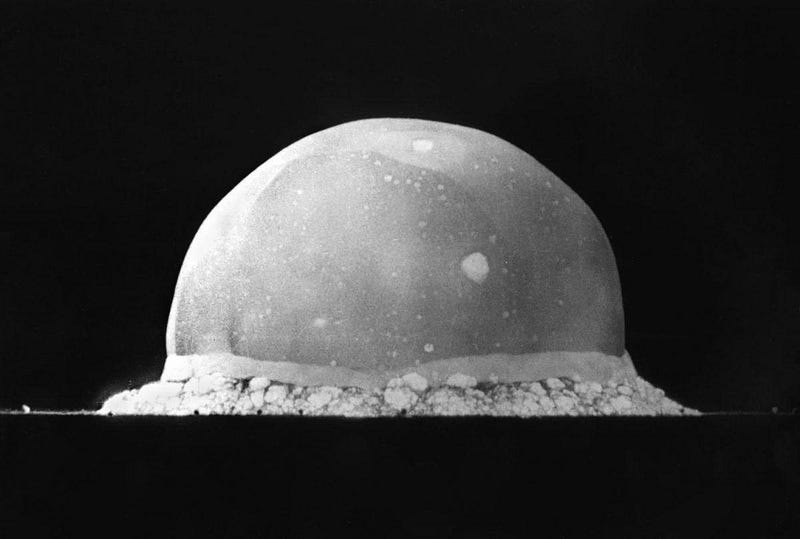
Whenever you have an explosion, regardless of whether it’s based on a combustion reaction, a nuclear explosion, a rupture caused by overpressurizing a container, etc., the following things are true.
- An explosion always begins at a specific location in space.
- An explosion initially occupies a small but finite volume.
- And an explosion expands rapidly outward in all directions, limited only by the external forces and barriers it encounters.
When you have an explosion, some material will often be caught up and/or affected by it, and will be pushed radially outward, with some of that material (typically the lightest stuff) moving outward the fastest. That fastest-moving material will spread out more quickly and farther than the rest of the material, and will become less dense as a result. Even though the energy density drops everywhere, it drops fastest farthest away from the explosion, because more energetic material becomes less dense faster: at the outskirts. Just by measuring the trajectories of these different particles, you can always reconstruct where the explosion occurred.
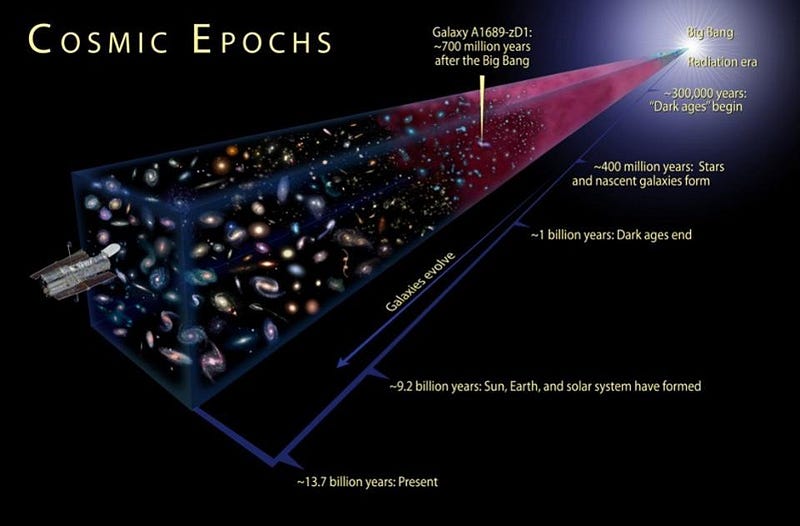
But this picture I’ve just painted for you — of an explosion — doesn’t match up with our Universe. The Universe looks the same here as it does a few million or even a few billion light-years away. It has the same densities, the same energies, the same number of galaxies in a given volume of space, etc.
The objects that are very far away do indeed appear to move away from us at greater speeds than the nearby objects, but they also don’t appear to be the same age as the slower, closer objects. Instead, as we go to extreme distances, the farther ones appear younger, less evolved, greater in number, and smaller in size and mass. Despite the fact that we can see galaxies out to distances in excess of 30 billion light-years, if we track how everything is moving and reconstruct their trajectories back to a common origin, we see the most unlikely of outcomes: the perceived “center” lands right on us.
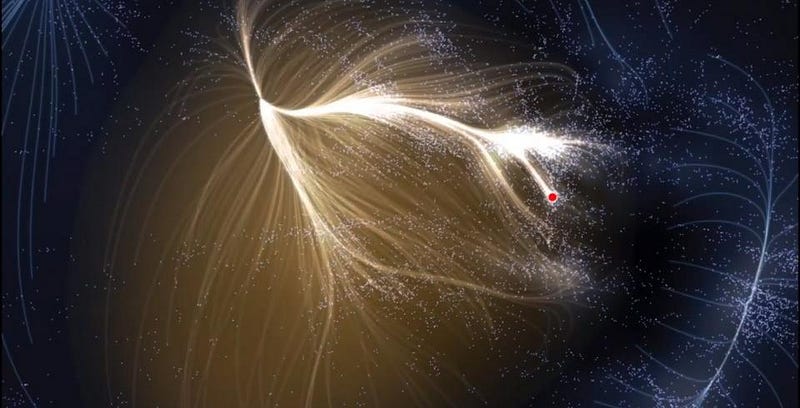
Our of all the trillions of galaxies in the Universe, what are the odds that we would just happen to be right at the center of the explosion that began the Universe? What are the odds, on top of those minuscule ones, that the initial explosion was configured in just such a way, complete with
- irregular, inhomogeneous densities,
- varying start times for star formation and galaxy growth,
- energies that vary tremendously from place-to-place in just the right, fine-tuned fashion,
- and a mysterious 2.7 K background glow in all directions,
to conspire so that we’re exactly at the center? There’s a lot we’d have to contrive to explain this, and many observations would still remain inexplicable. The explosion scenario isn’t just unrealistic; it’s in defiance of the known laws of physics.
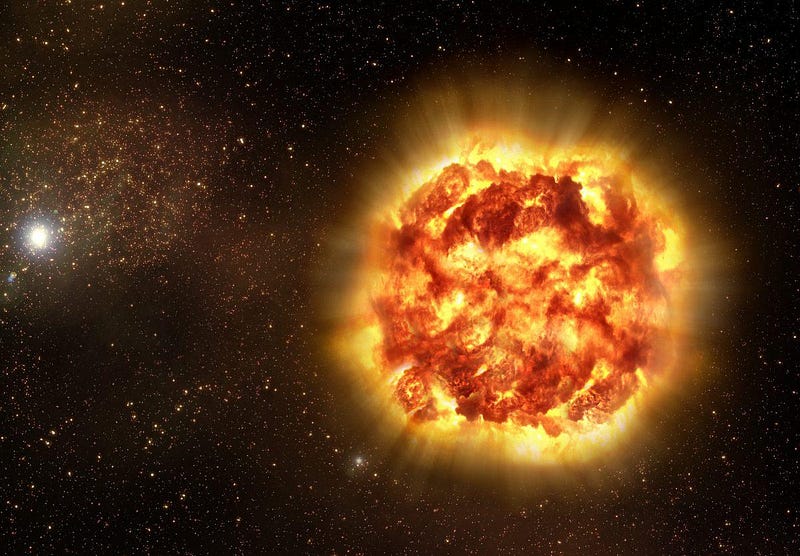
Instead, however, the law of gravity that governs our Universe — Einstein’s General theory of Relativity — predicts that a Universe full of matter and energy doesn’t explode, but instead expands. A Universe that’s full of equal amounts of stuff everywhere, with the same average densities and temperatures, must either expand or contract; since we observe an apparent recession, the expansion solution is the only one that’s physical. (The same way that the square root of 4 can be either +2 or -2, but only one of those will correspond to the physical number of apples in your hands.)
There’s a misconception that an expanding Universe can be extrapolated back to a single point; this isn’t true! Instead, it can be extrapolated back to a region of finite size with certain properties (i.e., filled with matter, radiation, the laws of physics, etc.), but then must evolve according to the rules that our theory of gravity lays out.
What this leads to, inevitably, is a Universe that has similar properties everywhere. This means that in any finite, equally-sized region of space, we should see the same density to the Universe, the same temperature to the Universe, the same number of galaxies, etc. We’d also see a Universe that appeared to evolve with time, as more distant regions should appear to us as they were in the past, having expanded less and having experienced less gravitational attraction and smaller amounts of clustering.
Because the Big Bang happened everywhere at once a finite amount of time ago, our local corner of the Universe will appear to be the oldest corner of the Universe that there is. From our vantage point, what appears to us nearby is almost as old as we are, but what appears at great distances is much more similar to what our nearby Universe was like many billions of years ago.
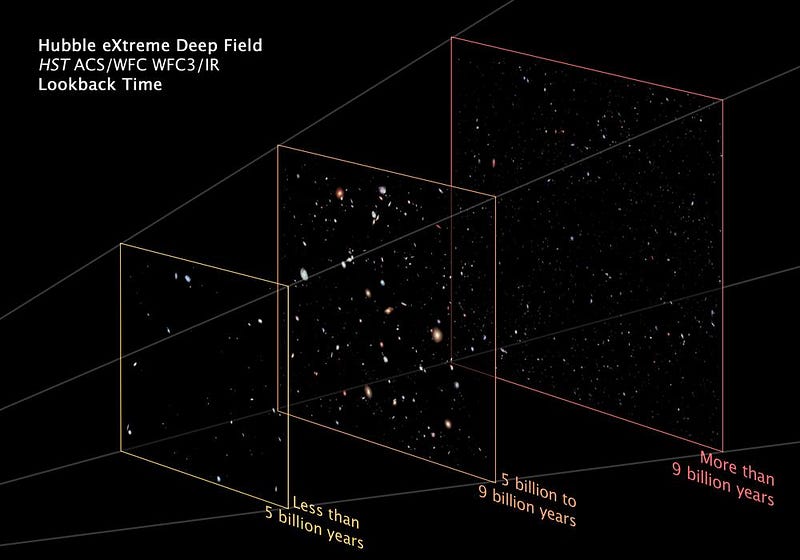
The distant galaxies that exist are constantly emitting light, and we are seeing the light that has arrived only after it has completed its journey to get to us through the expanding Universe. Galaxies whose light took a billion or ten billion years to get here appear as they were a billion or ten billion years ago. If we go all the way back, towards almost the moment of the Big Bang itself, we’d find that the Universe when it was that young was dominated by radiation, and not matter. It has to expand and cool for matter to become more important, energy-wise.
Over time, as that Universe expands and cools, neutral atoms can finally, stably form without being immediately blasted apart. The radiation that once dominated the Universe, however, still persists, and continues to cool and redshift due to the expansion of space. What we perceive today as the Cosmic Microwave Background is consistent with being the leftover glow from the Big Bang, but is also observable from anywhere in the Universe.
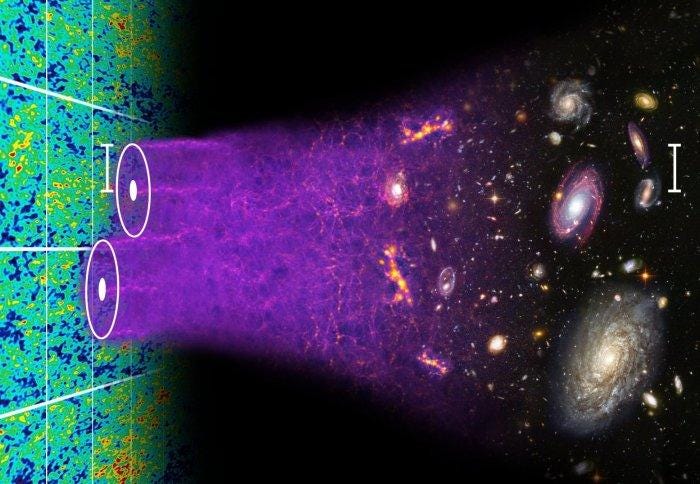
There isn’t necessarily a center to the Universe at all; it’s only our biased intuition that tells us there ought to be one. We can set a lower limit on the size of the region where the Big Bang must have occurred — it can be no smaller than the size of a soccer ball or so — but there is no upper limit; the region of space where the Big Bang occurred could even have been infinite.
If there truly is a center, it could literally be anywhere, and we would have no way to know. The portion of the Universe that is observable to us is insufficiently large to reveal that information, even if it could be true. We’d need to see an edge to the Universe (we don’t), or observe a fundamental anisotropy where different directions appear different (but we see the same temperatures and galaxy counts), and we’d need to see a Universe that appeared to be different from region-to-region on the largest cosmic scales (but it appears to be homogeneous instead).
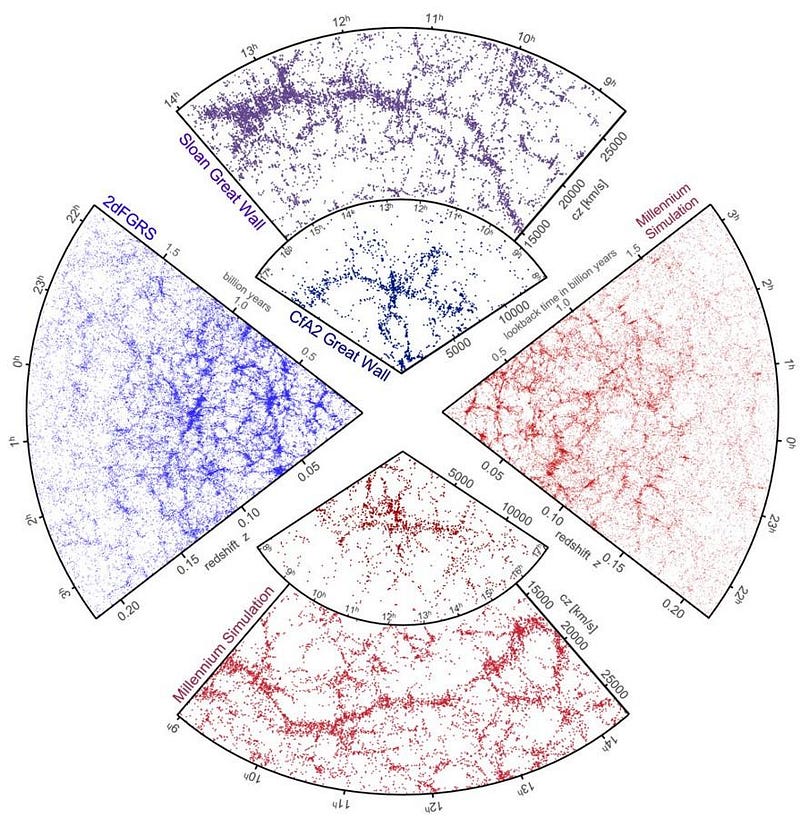
It sounds so reasonable to ask the question, “where did the Universe begin expanding from?” But once you realize all of the above, you’ll recognize that’s the wrong question entirely. “Everywhere, all at once,” is the answer to that question, and that’s largely because the Big Bang isn’t referring to a special location in space, but rather a special moment in time.
That’s what the Big Bang is: a condition that affects the entire observable Universe — and possibly a much, much larger region than that — all at once at one specific moment. It’s the reason why looking at objects that are farther away in space means that we’re seeing that object as it was at a moment in the distant past. It’s why all directions appear to have rough properties that are uniform regardless of where we look. And it’s why we can trace back our cosmic history, through the evolution of the objects we see, as far back as our observatories enable us to go.
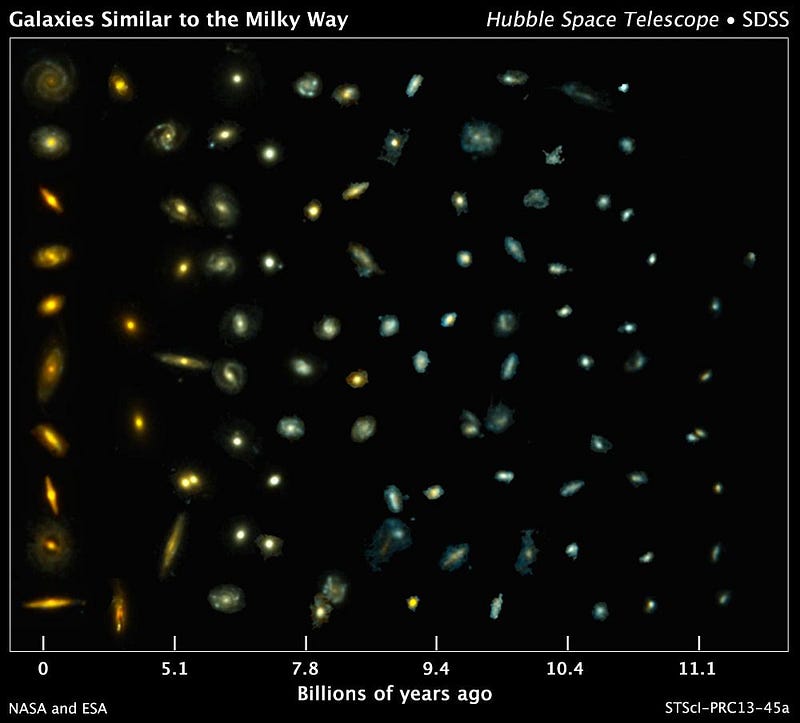
Despite all that we have access to — despite all that our theories and observations tell us — there’s still a tremendous amount that remains unknown to us. We don’t know what the actual size of the entire Universe is; we only have a lower limit that it must now be at least 46.1 billion light-years in radius in all directions from our perspective.
We don’t know what the shape of the fabric of space is, and whether it’s positively curved like a sphere, negatively curved like a saddle, or perfectly flat, like a sheet or a cylinder. We don’t know whether it curves back on itself or whether it goes on forever. All that we know is based on all we can observe. From that information, we can conclude that it’s consistent with being infinite in size, it’s consistent with perfect flatness, but information to the contrary may lie in the next significant digit of data or just beyond our observable cosmic horizon. It’s vital that we keep looking.
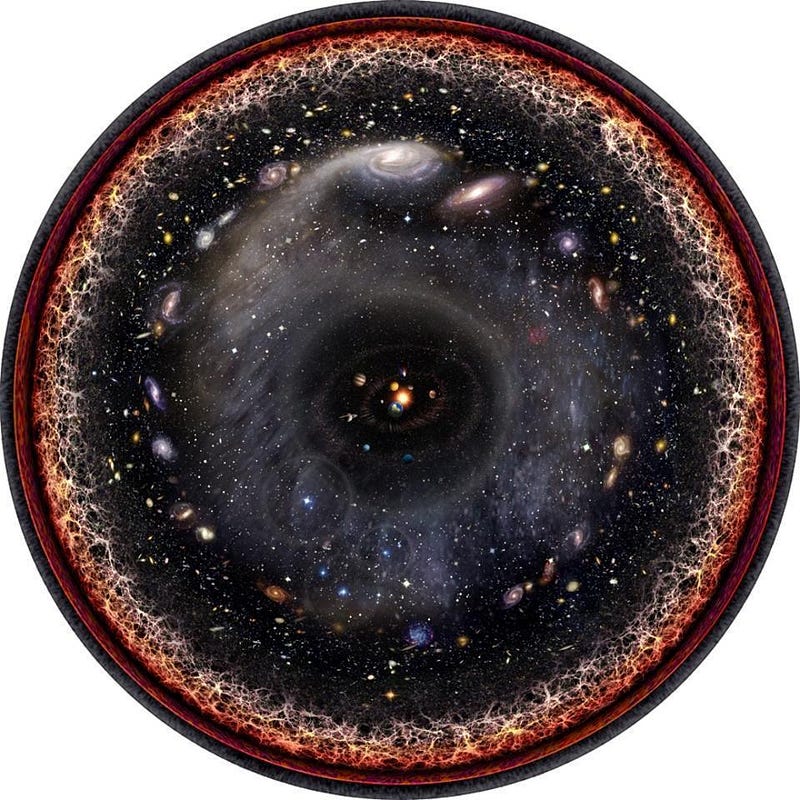
The reason we cannot know the true nature of the Universe — the entire, unobservable Universe — is because the portion that we have access to is finite. There’s a finite amount of information we’re capable of gleaning about our cosmos, even if we develop arbitrarily powerful instruments and detectors. It’s eminently plausible that even if we wait an infinite amount of time, we’ll never know whether the Universe is finite or infinite, or what its geometric shape is.
Whether you view the fabric of space as a leavening loaf of raisin bread or an expanding balloon with coins glued to the surface, you must keep in mind that the part of the Universe we can access is likely only a tiny component of whatever it is that actually exists. What’s observable to us only sets a lower limit on the entirety of what’s out there. The Universe could be finite or infinite, but the things we’re certain of is that it’s expanding, getting less dense, and that more distant objects appear as they were a long time ago. As astrophysicist Katie Mack notes:
The Universe is expanding the way your mind is expanding. It’s not expanding into anything; you’re just getting less dense.
Send in your Ask Ethan questions to startswithabang at gmail dot com!
Ethan Siegel is the author of Beyond the Galaxy and Treknology. You can pre-order his third book, currently in development: the Encyclopaedia Cosmologica.




